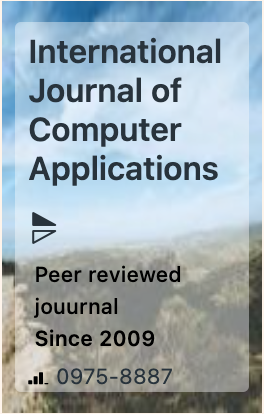The week's pick
Random Articles
Reseach Article
Real-time Threat Analysis and Improving Cybersecurity Defenses in Evolving Environments with Deep Learning and Traditional Machine Learning Algorithms
| International Journal of Computer Applications |
| Foundation of Computer Science (FCS), NY, USA |
| Volume 186 - Number 66 |
| Year of Publication: 2025 |
| Authors: Md. Anisur Rahman, Md. Sahidullah, Farjana Kamal Konok |
 10.5120/ijca2025924444
10.5120/ijca2025924444
|
Md. Anisur Rahman, Md. Sahidullah, Farjana Kamal Konok . Real-time Threat Analysis and Improving Cybersecurity Defenses in Evolving Environments with Deep Learning and Traditional Machine Learning Algorithms. International Journal of Computer Applications. 186, 66 ( Feb 2025), 31-39. DOI=10.5120/ijca2025924444
Abstract
Real-time threat analysis plays a critical role in modern cybersecurity, ensuring that systems remain protected against evolving cyber threats. This study aims to develop and evaluate a robust model for threat detection using a combination of deep learning and traditional machine learning algorithms. The proposed methodology employs deep learning techniques alongside traditional algorithms, leveraging a comprehensive threat detection dataset for training and validation. The model achieved the highest accuracy of 97% with minimal loss, converging efficiently within the initial training epochs. Results indicate that the model achieved reliable generalization with close alignment between training and validation performance, showcasing its effectiveness in detecting threats accurately. The contributions of this study lie in advancing cybersecurity mechanisms through the integration of machine learning models, paving the way for enhanced real-time threat detection and response. Future enhancements, including advanced architectures such as Transformers, are proposed to further improve performance and applicability across broader cybersecurity domains.
References
- Parn, E. A., & Edwards, D. (2019). Cyber threats confronting the digital built environment: Common data environment vulnerabilities and block chain deterrence. Engineering, Construction and Architectural Management, 26(2), 245-266.
- Senyo, P. K., Liu, K., & Effah, J. (2019). Digital business ecosystem: Literature review and a framework for future research. International journal of information management, 47, 52-64.
- Kasula, V. K., Yadulla, A. R., Konda, B., & Yenugula, M. (2024). Fortifying cloud environments against data breaches: A novel AI-driven security framework. World Journal of Advanced Research and Reviews, 24(01), 1613-1626.
- Admass, W. S., Munaye, Y. Y., & Diro, A. A. (2024). Cyber security: State of the art, challenges and future directions. Cyber Security and Applications, 2, 100031.
- Gupta, R., Mejia, C., & Kajikawa, Y. (2019). Business, innovation and digital ecosystems landscape survey and knowledge cross sharing. Technological Forecasting and Social Change, 147, 100-109.
- Arif, H., Kumar, A., Fahad, M., & Hussain, H. K. (2024). Future Horizons: AI-Enhanced Threat Detection in Cloud Environments: Unveiling Opportunities for Research. International Journal of Multidisciplinary Sciences and Arts, 3(1), 242-251.
- Goriparthi, R. G. (2023). AI-Augmented Cybersecurity: Machine Learning for Real-Time Threat Detection. Revista de Inteligencia Artificial en Medicina, 14(1), 576-594.
- Malhotra, P., Singh, Y., Anand, P., Bangotra, D. K., Singh, P. K., & Hong, W. C. (2021). Internet of things: Evolution, concerns and security challenges. Sensors, 21(5), 1809.
- Schmaltz, K., Thompson, S., Mendes, D., & Carvalho, J. (2024). Robust defense mechanisms against adversarial ransomware attacks: Implementing a universal network-level detection filter.
- Gadde, H. (2024). AI-Augmented Database Management Systems for Real-Time Data Analytics. Revista de Inteligencia Artificial en Medicina, 15(1), 616-649.
- Guo, J., Liang, H., & Long, J. (2024). Leveraging file system characteristics for ransomware mitigation in linux operating system environments.
- Balantrapu, S. S. (2024). Current Trends and Future Directions Exploring Machine Learning Techniques for Cyber Threat Detection. International Journal of Sustainable Development Through AI, ML and IoT, 3(2), 1-15.
- Nazir, A., He, J., Zhu, N., Wajahat, A., Ullah, F., Qureshi, S., ... & Pathan, M. S. (2024). Collaborative threat intelligence: Enhancing IoT security through blockchain and machine learning integration. Journal of King Saud University-Computer and Information Sciences, 36(2), 101939.
- Qureshi, S. U., He, J., Tunio, S., Zhu, N., Nazir, A., Wajahat, A., ... & Wadud, A. (2024). Systematic review of deep learning solutions for malware detection and forensic analysis in IoT. Journal of King Saud University-Computer and Information Sciences, 102164.
- Chen, Z., Liu, J., Shen, Y., Simsek, M., Kantarci, B., Mouftah, H. T., & Djukic, P. (2022). Machine learning-enabled iot security: Open issues and challenges under advanced persistent threats. ACM Computing Surveys, 55(5), 1-37.
- Akcay, S., & Breckon, T. (2022). Towards automatic threat detection: A survey of advances of deep learning within X-ray security imaging. Pattern Recognition, 122, 108245.
- Liu, H., & Lang, B. (2019). Machine learning and deep learning methods for intrusion detection systems: A survey. applied sciences, 9(20), 4396.
- Su, T., Sun, H., Zhu, J., Wang, S., & Li, Y. (2020). BAT: Deep learning methods on network intrusion detection using NSL-KDD dataset. IEEE Access, 8, 29575-29585.
- Vinayakumar, R., Soman, K. P., & Poornachandran, P. (2020). Evaluation of recurrent neural network and its variants for intrusion detection system (IDS). Deep Learning and Neural Networks: Concepts, Methodologies, Tools, and Applications, 295-316.
- Smys, S., Basar, A., & Wang, H. (2020). Hybrid intrusion detection system for internet of things (IoT). Journal of ISMAC, 2(04), 190-199.
- Ieracitano, C., Adeel, A., Morabito, F. C., & Hussain, A. (2020). A novel statistical analysis and autoencoder driven intelligent intrusion detection approach. Neurocomputing, 387, 51-62.
- Shaukat, K., Luo, S., Varadharajan, V., Hameed, I. A., Chen, S., Liu, D., & Li, J. (2020). Performance comparison and current challenges of using machine learning techniques in cybersecurity. Energies, 13(10), 2509.
- Alazab, M., & Tang, M. (Eds.). (2019). Deep learning applications for cyber security. Springer.
- Dixit, P., & Silakari, S. (2021). Deep learning algorithms for cybersecurity applications: A technological and status review. Computer Science Review, 39, 100317.
- Halbouni, A., Gunawan, T. S., Habaebi, M. H., Halbouni, M., Kartiwi, M., & Ahmad, R. (2022). Machine learning and deep learning approaches for cybersecurity: A review. IEEE Access, 10, 19572-19585.
- Sarker, I. H. (2021). Deep cybersecurity: a comprehensive overview from neural network and deep learning perspective. SN Computer Science, 2(3), 154.
- Chen, D., Wawrzynski, P., & Lv, Z. (2021). Cyber security in smart cities: a review of deep learning-based applications and case studies. Sustainable Cities and Society, 66, 102655.
- Geetha, R., & Thilagam, T. (2021). A review on the effectiveness of machine learning and deep learning algorithms for cyber security. Archives of Computational Methods in Engineering, 28(4), 2861-2879.
- Ferrag, M. A., Friha, O., Maglaras, L., Janicke, H., & Shu, L. (2021). Federated deep learning for cyber security in the internet of things: Concepts, applications, and experimental analysis. IEEE Access, 9, 138509-138542.
- Chukwunweike, J. N., Yussuf, M., Okusi, O., & Oluwatobi, T. (2024). The role of deep learning in ensuring privacy integrity and security: Applications in AI-driven cybersecurity solutions. World Journal of Advanced Research and Reviews, 23(2), 2550.
- Martínez Torres, J., Iglesias Comesaña, C., & García-Nieto, P. J. (2019). Machine learning techniques applied to cybersecurity. International Journal of Machine Learning and Cybernetics, 10(10), 2823-2836.
- Drugan, M. M. (2019). Reinforcement learning versus evolutionary computation: A survey on hybrid algorithms. Swarm and evolutionary computation, 44, 228-246.
- Chirra, D. R. (2020). AI-Based Real-Time Security Monitoring for Cloud-Native Applications in Hybrid Cloud Environments. Revista de Inteligencia Artificial en Medicina, 11(1), 382-402.
- Gemino, A., Horner Reich, B., & Serrador, P. M. (2021). Agile, traditional, and hybrid approaches to project success: is hybrid a poor second choice?. Project management journal, 52(2), 161-175.
- Xu, Q., Zhu, B., Cheng, B., Yu, J., Zhou, M., & Ho, W. (2019). Photocatalytic H2 evolution on graphdiyne/g-C3N4 hybrid nanocomposites. Applied Catalysis B: Environmental, 255, 117770.
- Abd Elaziz, M., Xiong, S., Jayasena, K. P. N., & Li, L. (2019). Task scheduling in cloud computing based on hybrid moth search algorithm and differential evolution. Knowledge-Based Systems, 169, 39-52.
- Itasoy, E., Rosenberg, V., Stavrakis, N., Dietrich, A., & Montanari, C. (2024). Ransomware detection on windows using file system activity monitoring and a hybrid isolation forest-xgboost model.
- de Campos Souza, P. V. (2020). Fuzzy neural networks and neuro-fuzzy networks: A review the main techniques and applications used in the literature. Applied soft computing, 92, 1
Index Terms
Keywords

